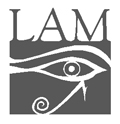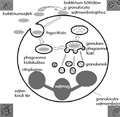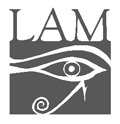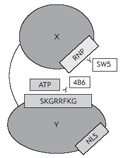The eLitMed.hu medical portal uses computer cookies for convenient operation. Detailed information can be found in the Cookie-policy.
Hungarian Immunology - 2007;6(01-02)
Content
[The immunmodulatory effect of 1,25 dihydroxyvitamin D3]
[1,25 dihydroxyvitamin D3, the biologically active metabolite of vitamin D3 plays an important role not only in bone and calcium metabolism but in differentiation of many cells and in the immunomodulation. It exerts its biological effects via vitamin D receptor (VDR) expressed in antigen-presenting cells and activated T cells. VDR is a member of the superfamily of nuclear hormone receptors. The receptor- ligand interaction activates nuclear transcription factors or the receptor binds directly to vitamin D responsive elements in the promoter regions of cytokine genes. Dendritic cells (DC) are the primary targets of vitamin D3; it inhibits the differentiation and maturation of DCs, and hereby DC-dependent T cell activation. These immunomodulatory activities have been demonstrated in vitro and in different models of autoimmune diseases and transplantation in vivo. In this report we review the regulatory effects of active vitamin D3 on the immune system and the latest results emphasizing the immunomodulatory role of 1,25 dihydroxyvitamin D3 which might be utilized more in therapy.]
[In vitro methods for measuring phagocytosis and killing of bacteria by neutrophil granulocytes]
[Accounting for about two-thirds of our white blood cells, neutrophilic granulocytes are key members of the innate immune system of the human body. They are terminally differentiated cells equipped with numerous antimicrobial weapons. Neutrophils are the first to arrive at sites of infections; their main mission is to phagocytose and destroy bacteria and funghi entering the human body. They fullfill a central role in both the inflammatory response of the body and the coordination of the innate and acquired immune systems’ function. Their deficient performance leads to impaired resistance of the host against microbes and to higher frequency of infections; their uncontrolled function, in turn, may damage our own tissues. Because of all of this, it is highly important from both basic and clinical perspective that we know as much as possible about the function of our neutrophilic granulocytes. In this paper methods available for measuring phagocytic and killing capacities of human neutrophils are reviewed. Each method has its advantages and disadvantages. The method chosen mainly depends on experimental tools available and informations needed.]
[Biological therapy of arthritis and systemic autoimmune diseases - 2007]
[Biological therapy acts at a specific point of inflammation. Today, rheumatoid arthritis is the prototype disease in this context due to the relatively high number of accessible patients and wellstandardized follow-up tools. However, apart from this disease, biological therapy has been introduced to the treatment of other diseases including various forms of arthritis, such as ankylosing spondylitis and psoriatic arthritis, as well as systemic autoimmune disorders, such as lupus, scleroderma, inflammatory myopathies and Sjogren’s syndrome. Anti-tumor necrosis factor-α (TNF-α) agents play a central role in biological therapy as these agents have been successfully tried in most of these diseases. However, when seeking for specific targets for biologicals, specific pathogenic factors of the given disease should be determined. For example, while anti-TNF agents seem to be most effective in various types of arthritis, anti-B cell therapy may be the first choice in other autoimmune conditions, such as lupus, Sjogren’s syndrome or dermatomyositis. It is important to consider the specific characteristics of the administered agents as there may be differences regarding side-effects.]
[Autoimmunity as a result of escape from RNA surveillance]
[The pathomechanisms of autoimmune diseases are still unknown. Numerous factors are thought to play a role in the formation of the diseases (genetic arrangement, hormonal factors, exogen and endogen viruses, etc.) and many hypotheses have been formulated to explain the role of these factors. Most of the theories suspect that disturbance of the immune system is the clue but according to other researchers the immune system performs properly and one has to find other alterations that could be blamed for the formation of the autoimmune diseases. The aim of our present work is to show that certain genetic alterations together with the mistake of the RNA surveillance system could lead to autoimmune reactions. Results of immune research conducted in the past two decades revealed that there are mutations in the hot spot region of exon 7 of the La gene in the peripheral lymphocytes of patients suffering from certain autoimmune diseases (Sjögren's syndrome, SLE). RNAs originated from the mutant gene contain premature termination codon and therefore the RNA surveillance mechanism should get rid of these RNAs in order to prevent the formation of mutant proteins. However, because of the mistake of the surveillance system mutant proteins are formed that could finally lead to the autoimmune reactions.]
1.
Clinical Neuroscience
Is there any difference in mortality rates of atrial fibrillation detected before or after ischemic stroke?2.
Clinical Neuroscience
Factors influencing the level of stigma in Parkinson’s disease in western Turkey3.
Clinical Neuroscience
Neuropathic pain and mood disorders in earthquake survivors with peripheral nerve injuries4.
Journal of Nursing Theory and Practice
[Correlations of Sarcopenia, Frailty, Falls and Social Isolation – A Literature Review in the Light of Swedish Statistics]5.
Clinical Neuroscience
[Comparison of pain intensity measurements among patients with low-back pain]1.
Clinical Neuroscience Proceedings
[A Magyar Stroke Társaság XVIII. Kongresszusa és a Magyar Neuroszonológiai Társaság XV. Konferenciája. Absztraktfüzet]2.
3.
Journal of Nursing Theory and Practice
[A selection of the entries submitted to the literary contest "Honorable mission: the joys and challenges of our profession" ]4.
Journal of Nursing Theory and Practice
[End of Life and Palliative Care of Newborns in the Nursing Context]5.
Journal of Nursing Theory and Practice
[Aspects of Occupational Health Nursing for Incurable Patients ]







